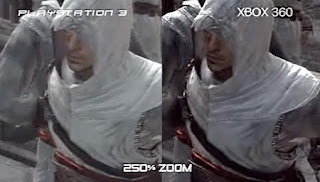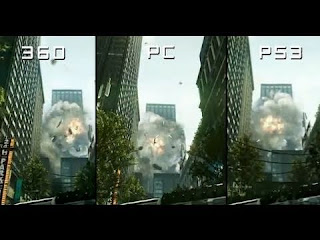It’s pretty clear that Sony’s Cell is more powerful than the Xbox. It was designed for high performance super computing. Yet despite its power, the PS3 doesn’t look that much better than it’s contemporaries. In fact, sometimes it looks worse. Graphics can occasionally look muddy or washed. You’ve probably heard that Sony went with a weaker and more outdated graphics chip than Microsoft did. This isn’t the case.
Both Sony and Microsoft went with slightly tweaked, off-the-shelf graphics chips for their consoles. The Xbox 360’s Xenos GPU, produced by ATI, is similar to the Radeon X1800 XL. The PS3’s nVidia RSX is virtually identical to the GeForce 7800 GTX. Both chips have identical specifications to their PC gaming counterparts. Naturally, you’d think the Xbox’s chip would outperform the Playstation’s. In real world tests, it doesn’t.
 |
| The PS3’s graphics look washed and blurry in the original Assassin’s Creed. From Techblog.com |
Pound per pound, the 7800 GTX is the fastest. I compared the two chips using Tom’s Hardware’s GPU charts from 2006. The ATI chip is only faster in Elder Scrolls IV: Oblivion, and only in an outdoor environment. Even then, improvements are marginal: about two frames per second difference. The GeForce beats it at everything else.
The PS3 actually has the more powerful CPU and GPU of the two consoles. So why does it tend to look worse, or struggle with certain games like Oblivion? It’s counter intuitive.
 |
| Crysis 2 is another example of where the PS3 falls short. Notice the missing details. From Androidguide.ru |
The potential culprit left is memory. This is where things get complicated. Both the PS3 and Xbox 360 have 512mb of RAM. The Xbox shares the entire 512mb block between it’s CPU and GPU. The PS3 splits it into two 256mb blocks dedicated to the CPU and GPU.
The Xbox dynamically allocates it’s memory usage. Basically, if the CPU only needs 128mb of RAM, then the GPU has the rest. It uses these for textures and other things it needs to store and quickly retrieve. The more memory the GPU has, the bigger the textures it can store. The bigger the textures, the better the image.
 |
| The Xbox 360 shares it’s RAM between the GPU and CPU. |
The PS3 on the other hand is locked in at 256mb. At the time of it’s release, this amount of memory was considered outdated. That’s another myth about it’s graphics. In fact, cards with 512mb or more were largely restricted to the enthusiast segment at the time. More RAM helps performance, but not by much. The two PC cards we looked at have 256mb and 512mb for the ATI and nVidia cards respectively. When we drop the 7800 GTX down to 256mb, performance suffers but only marginally. Even at high resolutions, both chips are evenly matched with nVidia still retaining a slight performance lead.
So how much performance does a graphically intense game of the period use? I loaded up Flight Simulator X on the PC and calculated it’s ram usage to be about 650mb evenly split between GPU and CPU. Keep in mind that PC isn’t an embedded system. So about 50mb of GDDR are likely being used for other stuff that’s running in the background. Namely the desktop.
That’s not the say that the PS3 wouldn’t benefit from more memory, though not necessarily for graphics. The Cell is a very powerful CPU hampered by a limited amount of system RAM. Our quick test shows that a period game easily consumes more CPU memory than the PS3 has. That’s not including all the other things Windows does in the background.
 |
| In recent third party games, the differences are much less noticeable. From Attackofthefanboy.com |
Ideally, the PS3 should have had 1gb of RAM, split in a 512/512 configuration. At minimum, 512mb of RAM should have been allocated to the CPU. So why didn’t they do this? Simple, because it would have cost too much.
The PS3 is very much a system built on compromises. At launch, it was already going for $600, which Sony was selling at a loss. Estimates peg actual manufacturing costs to be over $800. While the addition of pricey Blu-ray was heavily criticized, that eventually paid off in spades for Sony. The problem lies with other parts within the system.
Sony used Rambus XDR memory, which is notoriously expensive. It’s faster than the Xbox’s GDDR3 on paper, but real world performance improvements are dubious at best. On top of that, they insisted on full hardware PS2 backwards compatibility. The original PS3s literally had a Playstation 2 shoehorned inside them. Had they cut that from the beginning and focused on adding more memory, they would have had a better console.
That still doesn’t explain why the PS3 doesn’t look as good as the Xbox 360. The real answer is much more simple. At the time, nVidia and ATI were fighting a fierce arms race to build the best GPU. There were two schools of thought going at the time. One was to build a chip optimized for raw power. A GPU that, clock for clock, could produce higher frame rates and higher resolutions than its competitors. The other idea was to build a chip that focused it’s power on producing the sharpest and most vibrant images. nVidia went with speed, ATI went with image quality.
 |
| Uncharted 3 shows was a properly programmed game can do with the PS3. From Gamersyde.ca |
However, and it’s a big one, there are exceptions to this rule. Sony’s first and second party developers have created some beautiful games for the system. Games that exceed the Xbox in image quality. That’s because these games are better optimized for the hardware. That’s what it all boils down to: how the developer programmed their game.





